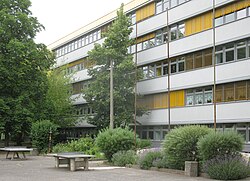Gutenberg School Berlin
| Gutenberg School | |
|---|---|

|
|
| type of school | Integrated secondary school with upper secondary school |
| School number | 11K04 |
| founding | 1979 |
| address |
Sandinostraße 10 |
| place | Berlin-Alt-Hohenschönhausen |
| country | Berlin |
| Country | Germany |
| Coordinates | 52 ° 32 '12 " N , 13 ° 29' 3" E |
| carrier | State of Berlin |
| student | 968 (school year 2019/20) |
| Teachers | 73 (school year 2019/20) |
| management | Gerhard Bethke |
| Website | www.gutenberg-oberschule-berlin.de |
The Gutenberg School is an integrated secondary school with upper secondary school in the Alt-Hohenschönhausen district of Berlin's Lichtenberg district at 10 Sandinostraße .
history
The school was opened in 1979 as the 23rd Oberschule Berlin-Weißensee in what was then Lüderitzstrasse (since 1984 Sandinostrasse). In 1986, she was named "Heinz-Gronau" 23 high school by Heinz Gronau , former commander of the Guards Regiment "Feliks Dzerzhinsky" the Ministry of State Security of the GDR .
As a result of the school structure reform in Berlin, the former comprehensive school with upper level has been a secondary school with upper level since the beginning of the 2010/11 school year. On November 16, 1993 it was named after the inventor of book printing, Johannes Gutenberg .
building
House A as the parent house was supplemented in the mid-1990s by two mobile classroom buildings (House B and C) and a mobile sports hall. For the school year 2022/23, a multi-storey extension building and a double sports hall including sports field are to replace buildings B and C as well as the current sports hall.
School profile
Classes include grades 7–10 (secondary level I) and 11–13 (secondary level II). Elective subjects are Spanish, French, Russian, fine arts, music or WAT (economics, work, technology). In the subjects of mathematics, English, German and the natural sciences, there are courses at different levels of ability in order to do justice to both high-performing and low-performing students.
The following qualifications are possible: vocational qualification, vocational qualification, advanced vocational qualification , intermediate school qualification (MSA), school part of the technical college qualification , Abitur (after 13 years, for particularly high-performing students also after twelve years).
As part of the open all-day operation, there is an offer from around 40 working groups.
Student body
The school has 968 students in the 2019/20 school year. Of them, 17 percent have a non-German language of origin.
The Gutenberg School is one of the ten integrated secondary schools in Berlin with the most in-demand.
Partnerships
Since 2003, the Gutenberg School has been one of around 300 UNESCO project schools in Germany.
Since the 2014/15 school year, it has been a partner school of the “ Students make school ” educational initiative , which enables student teachers to gain extensive practical experience in schools as early as possible. Since 2011 the school has been cooperating with the Berlin Police Section 61, which supports the school in teaching and in joint projects. There is a cooperation with the Federal Employment Agency Berlin-Mitte for career advice for the years 9–13.
In the “Gomel Project”, the Gutenberg School has been working with a Belarusian boarding school since 1999 , in which children and young people from socially disadvantaged families live. Every year, a group of students from the Gutenberg School visits the children in the boarding school, and every two years the school hosts around 20 Belarusian children.
The school has a sponsorship association with around 80 members.
Web links
Individual evidence
- ↑ Berlin school directory. Gutenberg School: student body
- ↑ Berlin school directory. Gutenberg School: School staff
- ^ Honorary name "Heinz Gronau" for school. In: Berliner Zeitung , October 29, 1986, p. 8.
- ^ School program of the Gutenberg School
- ↑ Working groups
- ↑ Language of origin of the students on www.berlin.de
- ↑ Registration numbers for secondary schools. Press release by the Senate Department for Education, Youth and Family, March 4, 2019.
- ↑ Only one in two people gets a place at Berlin's top secondary schools. In: BZ , March 4, 2019